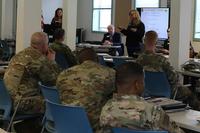In its current condition, the U.S. Court of Appeals for Veterans Claims can handle its caseload. But a judge on that court with close ties to The American Legion told Legionnaires at the 96th Annual National Convention in Charlotte, N.C., that things are changing.
Past National Commander Alan Lance, Sr., a judge on the U.S. Court of Appeals for Veterans Claims, told the Legion's Veterans Affairs & Rehabilitation Commission on Aug. 24 that staffing issues facing the court – along with an increase in appeals coming before it – could put the court in a precarious spot.
"Right now, we have nine judges, and we're adequately staffed and prepared to deal (with the current caseload)," said Lance, the Legion's national commander from 1999-2000 and a former Idaho attorney general. "Very soon, we're going to start losing judges. Unless Congress reauthorizes the maximum strength of nine judges, that strength will be reduced to seven judges at about the time (the court's caseload will increase).
"In addition to that, we have judges whose terms of service will expire, and it takes a while to get a judge nominated, confirmed and through the process. So … we're going to be pretty busy, we think. I'm sure we'll have some suggestions at the appropriate time, but right now we're just watching it come down the mountain, trying to figure out when it's going to hit and how much it's going to be."
In 2002, the Court of Appeals for Veterans Claims handled more than 17,000 cases. That caseload could approach more than 50,000 this year. "We're prepared to deal with it right now, but as circumstances change, we may be coming back and explaining our problems to you," Lance said.
An understaffed Department of Veterans Affairs' Group 7 – attorneys tasked with more or less prepping cases to go before the Court of Veterans Appeals and then argue cases on behalf of VA – will impact the court, Lance explained. "They're going to be requesting more time … and they're going to slow up the appellate process if they're not properly staffed," Lance said. "Our court has no control over this. It's the (VA) secretary's bailiwick. But if (Group 7's) processes slow down, then our processes will slow down. That's my concern."
Lance was part of a benefits claims panel discussion that also included two representatives from the Department of Veterans Affairs: one from the Veterans Benefits Administration (VBA) and one from the Board of Veterans Appeals (BVA).
There are approximately 300,000 appeals currently pending in various stages within VBA, said Cheryl Rawls, director of VA's Regional Office in Winston-Salem. The majority of those (187,000) are Notices of Disagreement – when a veteran disagrees with an initial VA ruling on a claim and requests it be reviewed within the VA and then by the courts. Another 60,000 are Form 9 appeals, which a veteran must file to get a case to go before the BVA.
Handling that caseload are almost 1,000 VBA employees focused specifically on appeals. Those employees have been using mandatory overtime to "assist and maintain a status, and being able to try to keep up with the push we have endured with getting rating claims done," Rawls said. "We're on pace to do a record number of claims this year."
Approximately 10-12 percent of people who file rating claims file appeals, Rawls said. Of those, 4-5 percent go to the (BVA); 1.2 percent of those decisions are overturned. But because of its workload, Rawls said VBA will continue to ask for help from service organizations such as The American Legion.
"We have continued to call upon you guys to help in increasing our (fully developed claim) numbers as a way of ensuring that from the start of the process, veterans are very aware … of what that process consists of," Rawls said. "And … we really need support on is to continue to have the funding so we can grow our Veterans Benefits Management System, our gateway to paperless. If we can continue to get that funding to move that paperless system along, I think that will also help us continue to be able to work toward minimizing the growth of the numbers of … ratings claims that we're doing."
James Ridgway, chief counsel for Policy and Procedure for the BVA, said that the board typically saw 40,000-,45,000 claims each year 10-15 years ago. Now, probably 150,000 claims are expected to go before the board. "In order for us to get that down, we have to decide substantially more (appeals) than we were deciding in the past," Ridgway said. "(And) the amount of work involved in any given appeal is going up because of more medical conditions now impacting each veteran."
Ridgway said that staffing levels at BVA are up 22 percent and productivity is up 30 percent. The board is considering a push for more video teleconference hearings, which are months faster to schedule. This year, 55 percent of the board's hearing will be via video teleconference. "The further we can push that number … we're making our judges more efficient. When we go out on travel board, 20-25 percent of veterans don't show up. That's time that the judges cannot use effectively. If a veteran doesn't show up for a video hearing, the judge can go back upstairs and continue to work on claims."










